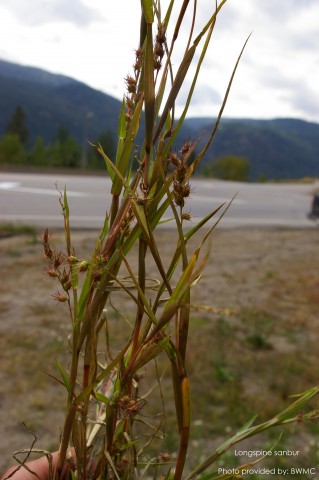WEED CONTROL: New invasive grass found near Christina Lake
A new invasive grass has been found growing in the Christina Lake area. Longspine sandbur (Cenchrus longispinus) was located at the pullout at the junction of East Lake Drive and Highway 3. This site was found late this fall so the treatment crew, funded through the Invasive Plant Council of BC, did their best to collect as much seed as they could when they pulled the plants at the site. This plant is new to our area and there may be other infestations, so please watch for this plant and report sightings to the Boundary Weed Management Committee.
Longspine sandbur, also known as burgrass or field sandbur, originates in the sub-tropical regions of North America so it is not considered to be indigenous to Canada. This annual grass is adapted to porous, sandy soils and has seed heads with spiny burs. Longspine sandbur thrives on sunny sites and frequently invades orchards, vineyards, cultivated cropland, lawns, roadsides, and other disturbed areas. It disperses primarily by hitching rides with people, animals, equipment, and irrigation water. The stiff spines on the burs can puncture your skin and easily gets caught and spread on tires. Identification Longspine sandbur may grow upright, but usually spreads out flat on the ground, forming a dense mat on the soil surface. The leaf sheaths are flattened, very loose, and have a tuft of short hairs where they join the blade. Leaves are light green and the seeds are round and spiky (4-6mm wide). Methods of Control The most effective method of control for Longspine sandbur is to prevent establishment through proper land management. Sandbur does not compete well in shaded conditions, so maintaining a healthy and productive natural plant community can help prevent invasion. Most competitive perennial plants will minimize invasion by utilizing water and nutrients that would otherwise be readily available to sandbur. Integrated management will require a combination of prevention and physical control. Longspine sandbur seedlings are easily controlled by shallow tillage, hoeing, or hand pulling. Repeated mowing every three weeks in the spring and summer will manage seed production. A new flush of seedlings often appears following each rain. Also, seed exposed soils immediately with a suitable grass seed mixture or native plants to prevent weed establishment. When pulling, if you wait until seeds are present, the plants must be bagged and disposed of at the landfill, to prevent further seed spread. There is no bio-control available for this grass. Some non-selective herbicides are effective when used in an integrated management strategy. Taking simple preventative measures will save time and money and protect the trails and beaches in Christina Lake and Boundary area from this prickly grass!
To report a location where this plant is growing, please contact Barb Stewart, the Boundary Weed Program Coordinator at 250-446-2232 or bwmc@nethop.net.
For more information on invasive plants visit www.invasiveplantcouncilbc.ca or contact the Boundary Weed Management Committee. The 2010 “Stop the Spread” Outreach Program is funded by Western Diversification Canada, Community Adjustment Fund.






















